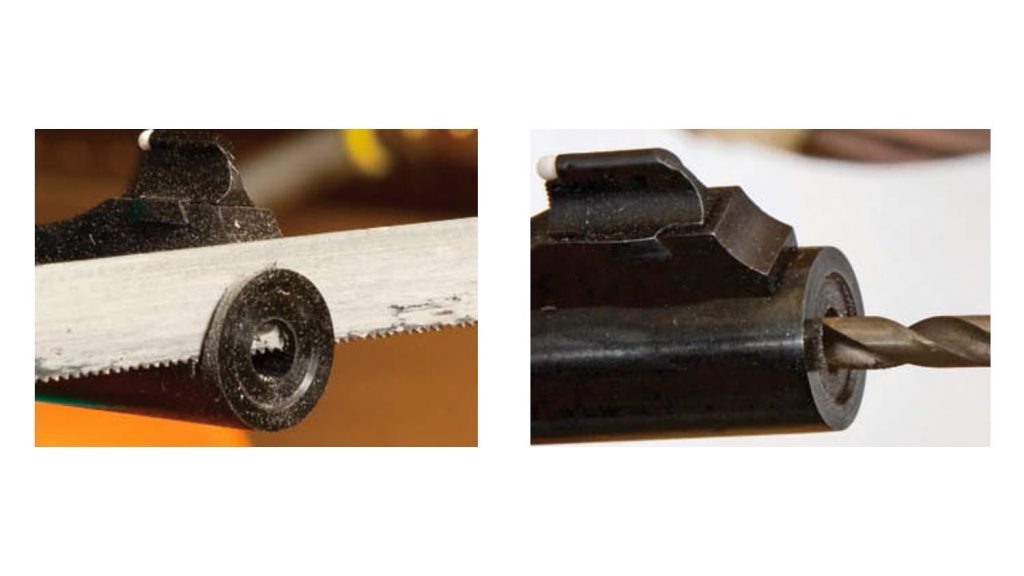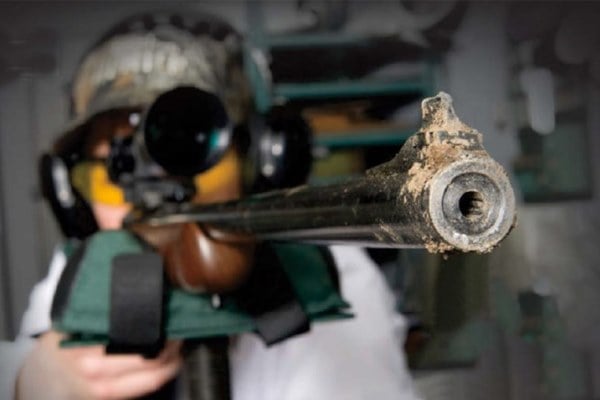To test whether damage to a rifle’s crown affects precision, we measured several rifles’ accuracy, desecrated their barrels, shot them again and compared the groups. Here’s what we learned.
If you’re like me, you are obsessed about preventing your rifle’s crown (where the barrel’s rifling is exposed at the terminal end of the muzzle) from being damaged because it’s commonly believed that crown damage can cause a bullet to exit the barrel erratically, thereby ruining precision. But I wanted to know exactly what happens when you nick your rifle’s crown with a cleaning rod, grind your muzzle on gravel and dirt, take a rat-tail file to it or even cut the crown off entirely with a hacksaw. At worst, I knew I’d ruin a few barrels and confirm what most of us already believe. But perhaps I’d find that I don’t have to obsess over the crown quite so much.
The Test
Four Thompson Contender Encore rifle barrels were scoped and sighted in at 50 yards. The Encore was chosen because its break-open action can better isolate the barrel. Five three-shot groups were fired through each barrel. Each group was measured, the largest and smallest were discarded and the averages of the remaining three were recorded. With the accuracy of each undamaged barrel recorded, each barrel was then dedicated to one of the four crown damage scenarios. Damage ranged from common causes like cleaning your rifle from the muzzle end (mild damage), to major damage and even extreme crown desecration that should never occur to a firearm and could be dangerous. After damaging all barrel crowns, the rifles were fired again in the exact same manner as the pre-damage test, with the same ammunition, from a Caldwell Lead Sled as before. A 50-yard, indoor range was chosen to reduce variables such as wind and fluctuating temperatures. Results were compared to the original groups to determine if crown damage influences precision and point of impact (POI).

Left: OK, so it was no accident that caused us to take a hacksaw to a .270 barrel. The damage was extreme. Right: We felt no pleasure in desecrating this poor bore. The .308-caliber looked more like a .45 after this extreme test.
The Findings
In all barrels tested, those with a damaged crown were less accurate when compared with the rifle’s undamaged accuracy data. All damaged barrels demonstrated slight to significant point-of-impact. While some of the accuracy losses and impact shifts seem negligible, they will likely be magnified as range increases. Nonetheless, if your barrel’s crown is damaged, your rifle may not be ruined: In most cases after damage, the first shot and first group on average were the most erratic. But after more rounds were fired, the groups typically began shrinking and migrating closer to the original POI. If your crown is lightly damaged (the barrel is not bent nor the muzzle obstructed), fire a box of cartridges through the rifle to see if the bullet’s natural honing action repairs the barrel to a usable state. If it is not satisfactory, take it to a gunsmith for re-crowning or have it re-barreled.
Conclusion
Does damage to the barrel’s crown hamper accuracy? The answer is: Yes. Overall, damage to the crown makes the rifle less consistent, but in all but extreme cases, the rifle may still be accurate enough to continue using at reasonable ranges. So the advice to pamper your barrel’s crown is well-founded. Do not clean it from the muzzle end—clean it from the chamber end. Keep your muzzle away from rocks and grit, and of course, whatever you do, refrain from cutting your barrel off with a hacksaw. The crown is best left pristine.
Some hunters advocate placing a piece of tape over the barrel to seal out the elements and debris. I’ve been reluctant to do so because of an upbringing that stressed the importance of keeping my muzzle absolutely free of foreign particles. But I wanted to know if sealing the barrel with tape affects pressure, accuracy and/or POI?
 Pressure Test
Pressure Test
The author found that placing a piece of electrical tape over your rifle’s crown to keep out debris is a good idea.
Using a strain gauge affixed to a Knight KRB muzzleloader and firing two Pyrodex pellets, a 250-grain Hornady SST saboted bullet with a 209 primer, five shots were fired each with one piece of electrical tape placed over the muzzle. Then five shots without tape were fired. Pressure (in psi) was recorded after each shot. The shots with tape averaged 13,760 psi while the five without tape actually averaged higher at 13,980.
Conclusion:
Placing a piece of electrical tape over your rifle’s crown to keep out debris is a good idea. In tests, differences in pressure (220 psi average) were within the test’s margin of error and statistically irrelevant. In six out of seven rifles tested, placing tape over the crown actually increased accuracy, but not enough to draw broad conclusions. POI shifts on undamaged barrels were insignificant at common hunting distances. This might be explained by the fact that after the shot, the tape did not have a bullet hole through it, but was sheared off cleanly from the edges of the muzzle, indicating that air or gas blew the tape off before the bullet could contact it. From these tests, I will now hunt with tape over my barrel’s crown; it could cheaply prevent a dangerous barrel obstruction. But before you do so, test your rifle first, or simply sight in with tape on the barrel.
Disclaimer: The American Hunter staff conducted tests in a controlled environment.
[box type=”shadow” align=”aligncenter” ]This article is reprinted with permission of the Shooting sports USA website. To see the original article, please visit https://www.ssusa.org/articles/2017/1/18/will-damage-to-a-rifles-crown-hamper-accuracy[/box]





Add comment